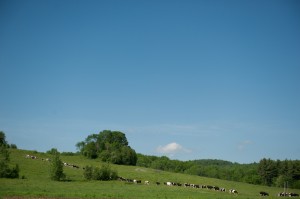So we were going to farm.
 So we made plans. Plans about how to shift the dairying, gradually, to more and more a pasture-based operation. Plans to introduce some other farming enterprises, like pastured poultry and a market garden, and to direct-market for fair prices. Plans to, eventually, wean ourselves off wholesale milk and onto grass-fed farmstead cheese and dairy products. The farm had the wholesale milk market, so we could introduce some changes gradually. Sarah had the photography business, and I could adjunct classes, to cushion our own financial needs while we built up some “sweat equity.” We didn’t have a place of our own to live, but were welcomed into my parent’s home. We all were willing to make some sacrifices; something would work out.
So we made plans. Plans about how to shift the dairying, gradually, to more and more a pasture-based operation. Plans to introduce some other farming enterprises, like pastured poultry and a market garden, and to direct-market for fair prices. Plans to, eventually, wean ourselves off wholesale milk and onto grass-fed farmstead cheese and dairy products. The farm had the wholesale milk market, so we could introduce some changes gradually. Sarah had the photography business, and I could adjunct classes, to cushion our own financial needs while we built up some “sweat equity.” We didn’t have a place of our own to live, but were welcomed into my parent’s home. We all were willing to make some sacrifices; something would work out.
 But it didn’t. Our immediate community—many the selfsame subscribers to the virtue of Cheapness—in large part scoffed and balked at our fair prices for conscientiously grown and raised products. Over the year, we at times clashed over farming philosophy and ideology with my father (largely along the lines of conventional vs. organic). These probably would have been manageable, had there not also been an issue with ownership, financial responsibility, and transfer and transition of the farm—not between my parents and Sarah and I, but between and among the previous generation. Transition was not going as anticipated, and ultimately it seemed folly for us to remain with the family farm when the future of its “family” status was uncertain. The short of the matter is that farmland generally is more valuable on the books than it is for the farm business, and lifelong family labor has an often unrecognized value that may not in the long term be actually or fairly compensated.
But it didn’t. Our immediate community—many the selfsame subscribers to the virtue of Cheapness—in large part scoffed and balked at our fair prices for conscientiously grown and raised products. Over the year, we at times clashed over farming philosophy and ideology with my father (largely along the lines of conventional vs. organic). These probably would have been manageable, had there not also been an issue with ownership, financial responsibility, and transfer and transition of the farm—not between my parents and Sarah and I, but between and among the previous generation. Transition was not going as anticipated, and ultimately it seemed folly for us to remain with the family farm when the future of its “family” status was uncertain. The short of the matter is that farmland generally is more valuable on the books than it is for the farm business, and lifelong family labor has an often unrecognized value that may not in the long term be actually or fairly compensated.
We felt trapped. Sarah had left a good job and good friends, and the photography business lulled with our relocation. I was making little progress finishing my dissertation, and now felt out of the academic loop. Plus, we still felt we could and should farm. But where? How? As many a young or new farmer knows, and those familiar with their plight, access to land and capital is a huge stumbling block.
When we moved, or returned, to Vermont, Sarah’s mother Joanna (her family had lived in Massachusetts, not too far from us in Rhode Island) obtained a tenure-track teaching job in Plattsburgh (not too far from my family in Vermont). Joanna spent the fall semester living in an apartment, while Sarah’s father Donnie remained at his job in Mass, staying with their house which was on the market; when it sold, he was already approved to telecommute, and the ‘rents would find a place near Plattsburgh.
Things fell into place. Could we—Sarah, myself, our kids, and her parents—find a place together? We had actually long talked about and considered multi-generational co-habiting. A few good farm-friendly real estate options presented themselves, and one of them, in Saranac, New York, outshone the rest. The home in Massachusetts sold after the turn of the year, and an offer was accepted on the farmstead in New York. So now, after a hectic move and home renovations, we find ourselves living and farming together, here in a welcoming community is Saranac.
And now I find myself a dairy farmer, again. Doing, I hope, “Good” Things (which I’ll talk about in Parts 4 and 5).
